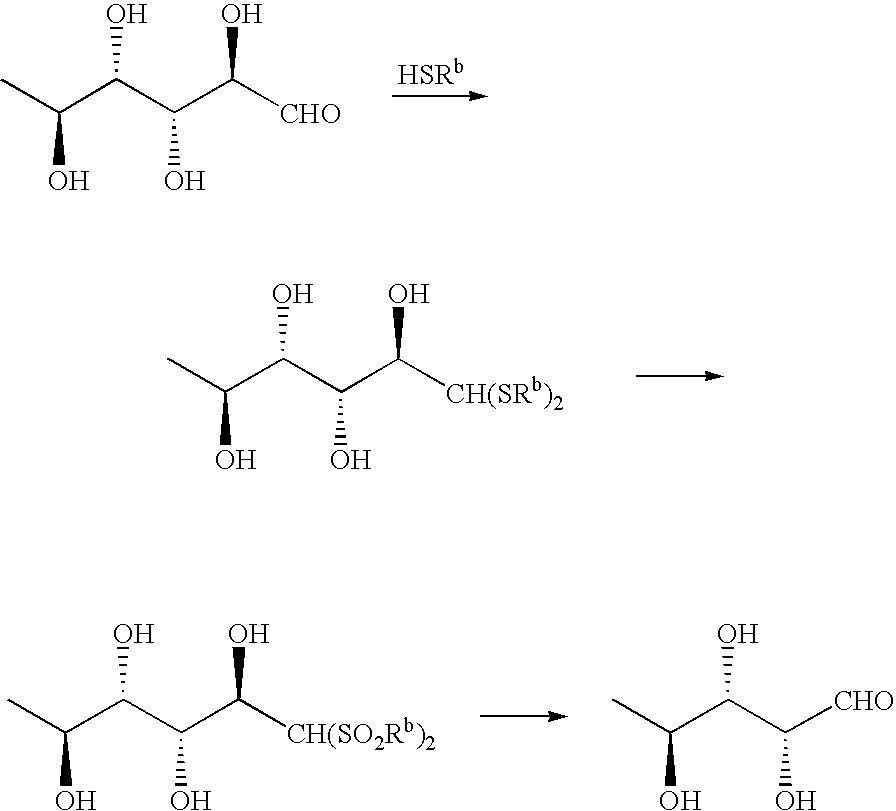Process for Producing Carbon-Reduced Aldose Compounds
- Summary
- Abstract
- Description
- Claims
- Application Information
AI Technical Summary
Benefits of technology
Problems solved by technology
Method used
Image
Examples
example 1
Production of L-Rhamnose Didodecylmercaptal (XVI)
[0071]
[0072]In 20 mL of dioxane, 4.00 g (22 mmol) of L-rhamnose (V) hydrate was dissolved by heating; the solution thus obtained was added dropwise in a 4-N hydrochloric acid / dioxane solution of 8.89 g (44 mmol) of n-dodecanthiol at room temperature with stirring. On completion of dropwise addition, the reaction solution was transparent, and white crystals were precipitated with the progress of the reaction. The reaction solution was stirred at room temperature for 12 hours, and the precipitated white crystals were filtered off, washed with ether and then dried to yield 9.00 g (yield: 75%) of L-rhamnose didodecylmercaptal (XVI) as colorless crystals. This product can be used without further purification in the subsequent reaction; however, the product was recrystallized from dioxane, and thus was able to be obtained as colorless needles.
[0073]Melting point: 111 to 112° C.
[0074]IR (cm−1): 2917, 2850, 1467, 1064, 972, 894, 721, 613, 507...
example 2
Production of 1,1-Didodecylsulfonyl-1-manno-2,3,4,5-tetrahydrohexane (XVII)
[0076]
[0077]In 100 mL of acetic acid, 4.0 g (7.26 mmol) of the L-rhamnose didodecylmercaptal (XVI) obtained in above-mentioned Example 1 was dissolved by heating; to this solution, 40 mL of 30% hydrogen peroxide solution was added dropwise under strong stirring. On completion of addition, the reaction mixture was continuously stirred at room temperature for 18 hours. The reaction mixture with a white precipitate produced therein was diluted with water, and extracted with ethyl acetate. The extract thus obtained was dried and then concentrated. The white precipitate thus obtained was filtered off, and dried to yield 4.02 g (yield: 90%) of 1,1-didodecylsulfonyl-1-manno-2,3,4,5-tetrahydrohexane (XVII). This product can be used without further purification in the subsequent step; however, the product was recrystallized from acetic acid, and thus was able to be obtained as colorless needles.
[0078]Melting point: 11...
example 3
Production of 5-deoxy-L-arabinose (VIII)
[0081]
[0082]In 10 mL of dioxane, 1.00 g (1.62 mmol) of the 1,1-didodecylsulfonyl-1-manno-2,3,4,5-tetrahydrohexane (XVII) obtained in above-mentioned Example 2 was dissolved, and the solution thus obtained was added under stirring with 5 mL of 28% aqueous ammonia. The thus obtained mixture was stirred at room temperature for 1 hour, and didodecylsulfonylmethane precipitated as a white crystalline precipitate was filtered off to be removed, and the filtrate was concentrated. The residue was added with water and extracted twice with chloroform. The organic layers were combined and concentrated to yield 0.17 g (yield: 80%) of 5-deoxy-L-arabinose (VIII) as a pale yellow oily product.
[0083]IR (cm−1): 3350, 1650, 1560, 1450, 1410, 1380, 1310, 1125, 1060, 1030, 980, 835.
[0084]NMR (D2O / ppm): 5.10 (1H, d), 5.07 (1H, d), 3.99 (1H, m), 3.90 (1H, m), 3.58 (1H, m), 1.63 (3H, d).
[0085]In above-mentioned Examples 1 to 3, no malodor characteristic of the merca...
PUM
 Login to View More
Login to View More Abstract
Description
Claims
Application Information
 Login to View More
Login to View More - R&D
- Intellectual Property
- Life Sciences
- Materials
- Tech Scout
- Unparalleled Data Quality
- Higher Quality Content
- 60% Fewer Hallucinations
Browse by: Latest US Patents, China's latest patents, Technical Efficacy Thesaurus, Application Domain, Technology Topic, Popular Technical Reports.
© 2025 PatSnap. All rights reserved.Legal|Privacy policy|Modern Slavery Act Transparency Statement|Sitemap|About US| Contact US: help@patsnap.com



